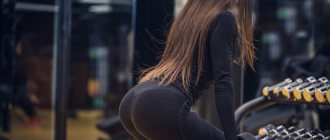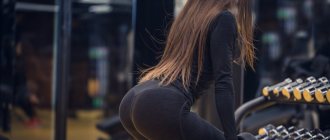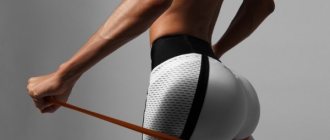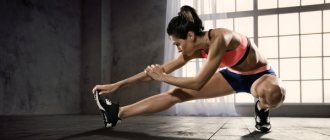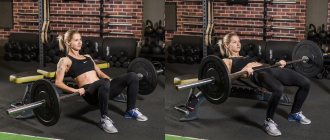Features of training the buttocks and thighs
The wrong approach to training can cause a lack of results. To avoid this, adhere to the following principles:
- Power load. We recommend that men select the weight of the weights so that in each approach they do 6-12 repetitions with effort on the last two, girls - 15-20;
- Frequency of classes. Men's lower body training should not be more than once a week. Women's training for legs and buttocks can be done 2 times a week with a break of 3-4 days;
- Program structure. Basic multi-joint exercises (squats, leg presses, etc.) should be performed at the beginning of the session, as they consume a large amount of energy;
- Technique. Don't try to quickly pump up your legs and buttocks. Learn how to perform basic exercises correctly. This way you will protect yourself from injury and will gradually progress.
- Variability of training. The muscles of the legs quickly “adapt” to monotonous exercises. Therefore, we recommend modifying your training plan every 8-10 weeks.
Back lunges with dumbbells in hands
Back lunges with dumbbells in hands. Initial position.
Back lunges with dumbbells in hands.
Finish. Execution: Take dumbbells in your hands and stand straight. Take alternate steps back with your left and then with your right foot. Moving your leg back, squat on the other leg. This is a lunge. At the same time, tilt your body forward and try to bend at the lower back, without slouching. This allows you to properly stretch and feel the gluteal muscle. Take a deep breath as you lunge. When returning to the starting position, exhale. Do at least 2-3 sets of 10-15 repetitions (on each leg). Gradually increase the weight of each dumbbell. It’s normal for a woman to do lunges with 10-12 kg dumbbells, and a man to do lunges with 25-30 kg dumbbells.
The exercise develops the buttocks and quadriceps muscles of the thighs. Improves flexibility.
Learn more about the exercise - backward lunges with dumbbells in your hands.
Examples of training programs for men and women
Note that it is almost impossible to pump up your butt and legs at home. The maximum that can be achieved is a beautiful relief of the lower body, muscle tone and a reduction in fat. Therefore, the proposed programs are designed for training in the gym.
Strength program for men
Performed once a week in combination with other workouts for the back, chest, and shoulders.
- Warm up on a treadmill or with a jump rope (5-7 minutes);
- Barbell squats (4/6-8);
- Forward lunges with kettlebells (3/10-12);
- Leg press (3/10-12);
- Romanian deadlift (3/10-12);
- Leg extension while sitting in a machine (3/10-12);
- Lying leg curls in the simulator (3/10-12).
We recommend finishing your lower body workout with light stretching. This will help you recover faster and reduce your soreness.
Legs and buttocks training for girls
The program can be performed twice a week, for example on Monday and Friday. At the same time, it is advisable to train the rest of the body muscles on free days.
- Warm up on a treadmill or with a jump rope (10-15 minutes);
- Smith machine squats (4/15-20);
- Cross lunges with dumbbells (3/15-20);
- Plie squats (3/15-20);
- Bulgarian lunges with dumbbells (3/15-20);
- Weighted gluteal bridge (3/15-20).
If you are overweight, we recommend finishing your session with an aerobic cool-down, such as pedaling an exercise bike or jumping rope for 15 minutes.
Top 7 exercises for which your legs and buttocks will thank you
So, now let's get down to the practical part - directly performing exercises to tighten and strengthen the buttocks.
Classic squats
The load is focused on the gluteus maximus, quadriceps and other muscles of the thigh: vastus, vastus intermedius, rectus, gracilis, pectineus, adductors long, major and short. The abs and back are also involved. There are as many as 7 types of effective squats, but we will look at the classic ones.
- The heels are slightly wider than the shoulders, the toes are turned slightly outward, the stomach is pulled in, the shoulders are straightened, the back is straight. Hands at your sides.
- Take a deep breath and squat. The knees do not protrude beyond the line of the toes, because we sit upright. Hips – parallel to the floor. The angle of the bent knees at the lowest point is no less than 90. Hands are in front of you at chest level.
- As you exhale smoothly, rise up.
The recommended amount of load is 3 sets of 10 repetitions.
Also check out the effective 30-day squat program.
There are many varieties of squats: with dumbbells or a barbell, ballet plie (sumo), on feet together, deep curtsy, side or “pistol” on one leg (the other on the bench).
Peculiarity! When squatting with a barbell or bodybar, the movement is similar to sitting on a chair. The back is straight all the time, the gaze is forward, not down or up, the shoulders are pulled back, each hand firmly holds the load behind the back by 15-20 cm beyond shoulder width. Improper execution of the exercise can be dangerous!
Side Lunges
The main load falls on the gluteus maximus and thigh muscles: rectus, vastus literalis and medialis, rectus, biceps and semitendinosus.
Find out about 7 other types of lunges here.
There are many variations of this exercise - regular, walking, with a knee lift, reverse (with a step not forward, but backward), on one leg, lateral (to the side), with or without weights.
- Feet shoulder width apart. Hands, if there is no bodybar, on the belt.
- Step to the side and squat with this leg while taking a deep breath. The second, supporting leg is straight, its inner arch is pressed to the floor.
- When standing up with the force of a bent working leg, exhale.
3 sets of 10 repetitions on both legs will be enough.
Peculiarity! The Side Lunge exercise strengthens the inner thighs and breeches.
Gluteal bridge
All three gluteal muscles are worked, as well as the spinal extensors, quadriceps and biceps hamstrings. The glute bridge has 6 different options.
- We lie on the floor, arms along the body, legs shoulder-width apart, knees bent at an angle of 100-110°, feet firmly planted on the floor.
- As you exhale, lift the pelvis without lifting the feet, shoulders and head from the floor; the raised body should form a diagonal. At the top point - maximum tension in the buttocks and delay for several seconds.
- As you inhale, smoothly, without jerking, lower your pelvis and take your starting position.
Do 3 sets of 8-10 reps.
Varieties of the exercise - one-sided bridge with support on one leg, with legs placed on an elevation, with weights.
Carefully! Hold the weight (barbell or plate) with both hands and place it on the crook of your thigh, not on your stomach.
Swing your legs to the side
The muscles involved are the gluteus maximus, quadriceps, biceps (hamstrings), long back muscles, abs, and, when performed to the side, the gluteus medius. What other swings are there for slimming your thighs?
- We stand, hands on the belt, to the sides at chest level, or one on the belt, the other holding the handrail. The back is straight, looking forward.
- As you exhale, lift your leg to the side to the maximum available to you, fix it for a moment. The foot is in the same position as it was on the floor, the toe is on itself. Keep your body straight, do not lean to the side of the leg you are lifting.
- Inhale – lower your leg back into place.
2 sets of 10-15 repetitions.
Watch the video for more details:
Important! There is no need to raise your leg until it hurts - just until you feel a slight burning sensation. Alternate legs, one approach - performing the required number of repetitions with one leg, then the other.
Hyperextension for the buttocks
Depending on a particular technique, the extensors of the back muscles, biceps, semitendinosus and semimembranosus muscles of the thigh and the gluteus maximus are loaded. There are as many as 5 varieties of performing hyperextension - on a machine at an angle of 45°, on a large fitball or bench, the reverse version with a stationary torso and working legs, and horizontal (performed at home, without any equipment). Let's look at the last one.
- We lie on our stomachs, arms extended forward, legs backward.
- As we inhale, we begin to raise our arms and legs at the same time, forming an arc (option: the legs are placed under the closet and only the upper part of the body rises with the arms raised parallel to the body or bent at the elbows and placed behind the head).
- As you exhale, return to the starting position.
3 sets of 15-20 lifts are recommended.
Important! When performing the exercise, the risk of injury to the tendons and spine is eliminated, but the back, lower back and buttocks are strengthened, and a beautiful and strong posture is formed. For this purpose, it is important to perform it in case of such consequences of a sedentary lifestyle as osteochondrosis, hernia or protrusion, scoliosis.
Exercise "Bicycle"
Combined training of the oblique and rectus abdominis muscles, small and medium gluteal muscles, adductors and the muscles of the back of the thigh. This movement also burns fat around the waist and makes it thinner. Abdominal training must be included in the complex.
See here about 3 different types of “Bicycles”
- We lie on our backs, hands clasped behind our heads. Shoulders and legs are slightly raised. Bend your legs at the knees, shins parallel to the floor.
- As you exhale, pull your left leg towards your right elbow, then vice versa, as if turning invisible pedals. Exhale - during a forceful effort, inhale - when changing arms and legs.
3-5 sets of 15-30 repetitions.
Learn more from the video:
"Walking on your buttocks"
The muscles on which the load is emphasized are all buttocks and thighs. There are as many as 7 beneficial properties of “Walking on the buttocks” from Professor Neumyvakin for the pelvic area. And here you can familiarize yourself with various options for its implementation.
- We sit on the surface, legs straight, back straight - at an angle of 90° to the legs. Hands behind your head or bent at the elbow at the same angle, as if you were about to run.
- Start walking. Without bending, move your legs forward one at a time and slowly, without jerking, move forward on your buttocks. It is better not to drag your leg , but to lift it in the air. Help yourself with your whole body.
- Having walked forward, you can walk back a little.
Walk 10 to 40 minutes a day.
You can start with 2-5 minutes. Peculiarity! In addition to pumping, it is also an excellent massage of the abdomen and pelvis, which is especially useful for women.
In addition to beauty and the ability to wear tight-fitting outfits, training the buttocks and thighs burns fat, increases metabolism and the total volume of muscle mass of the whole body, increases overall endurance and strength of the body, helps build a symmetrical body, strengthens the brain-muscle connection, acts as a preventative and has a therapeutic effect for osteoporosis, arthritis, osteochondrosis, have a positive effect on the cardiovascular system.
As you can see, there are enough reasons. So don't waste time and start right now!
Hamstring exercises
Leg curls in the simulator
The exercise is performed in a leg curl machine, concentrating the load on the biceps femoris muscle. The athlete lies on his stomach, rests his feet on the bolster and raises them until they are perpendicular to the floor, then slowly lowers them.
Pros of the exercise:
| Increase in total hip volume |
| Giving distinct relief to the hamstrings |
Hyperextension
Hyperextension
The hyperextension exercise tones the erector spinae muscles and strengthens the buttocks. Safe for the spine.
Pros of the exercise:
| Works well on the back extensor muscles and hamstrings |
| This exercise prepares the lower back and stabilizer muscles for exercises such as deadlifts and squats. |
Romanian barbell deadlift
Romanian barbell deadlift
A variation of the deadlift in which the athlete lifts and lowers the barbell without practically extending his legs. At the end point, the bar does not drop to the floor, stopping just below the knees.
Pros of the exercise:
| One of the best exercises for the hamstrings and gluteal muscles, as it can deeply work all their areas. |
| Works the back extensor muscles just like the classic deadlift |
| Involves many auxiliary muscles (lumbar muscles, calf muscles, core muscles, etc.) |
Exercises for the inner thigh[edit | edit code]
Bodyweight exercises[edit | edit code]
- Working out lying on your side with a bent leg
- Plie squats
- Sumo squat
- Working out lying on your side with a bent leg
- Plie squats
- Sumo squat
Weight-bearing exercises[edit | edit code]
- Wide-legged barbell squats
- Working out the inner thigh with a ball
- Wide-legged barbell squats
- Working out the inner thigh with a ball
Exercises on simulators[edit | edit code]
- Leg abduction on the simulator
- Standing leg adduction on a cable machine
- Leg abduction on the simulator
- Standing leg adduction on a cable machine
A circular complex that will quickly get you in shape
What is the advantage of statics over dynamics? As you know, almost all physical training can be roughly classified into:
- Aerobic , in which importance is attached to the heart rate indicator, for example, exercise bike, aerobics, running, race walking, jumping rope.
- Stretching exercises - all kinds of leg stretches while sitting on the floor, twisting, splits.
- Dynamic. Dynamics – movement, that is, all exercises for repeating the same movement a certain number of times; for example, take regular squats.
- Static is training in which muscles work without moving parts of the body, and that’s what we’ll talk about.
Subscribe to our INSTAGRAM account!
And it is during static conditions that our muscles:
- They are subjected to maximum prolonged tension without the opportunity to relax, as is done in dynamics.
- Parts of the body in a static exercise are motionless.
- Static exercises performed at half strength are usually aimed at maintaining the weight of your own body in a certain position (classic “plank”).
- Static exercises, performed at full strength, are aimed at overcoming an obstacle (“moving the wall”).
- They are aimed at strengthening tendons, as opposed to dynamics, in which only muscles are developed.
- As a result, regular static exercises develop not so much muscle relief, but practical muscle strength (there is a classic example of a jock who is unable to unscrew the lid of a sealed jar).
- Due to the fact that in static training (but only those performed at half strength) predominantly red muscle fibers work, the main role of which is burning fat and producing energy, these exercises contribute to almost one hundred percent “drying out” of excess muscles, eliminating excess liquid and fat and giving, in the case of our topic, your legs and buttocks a perfectly elongated and elastic shape.
- In addition, it is the red fibers that are surrounded by a large network of capillaries, so their work increases the influx/outflow of oxygen in general, which has a beneficial effect on the blood supply to the muscle mass, as well as on the state of the cardiovascular system in general.
